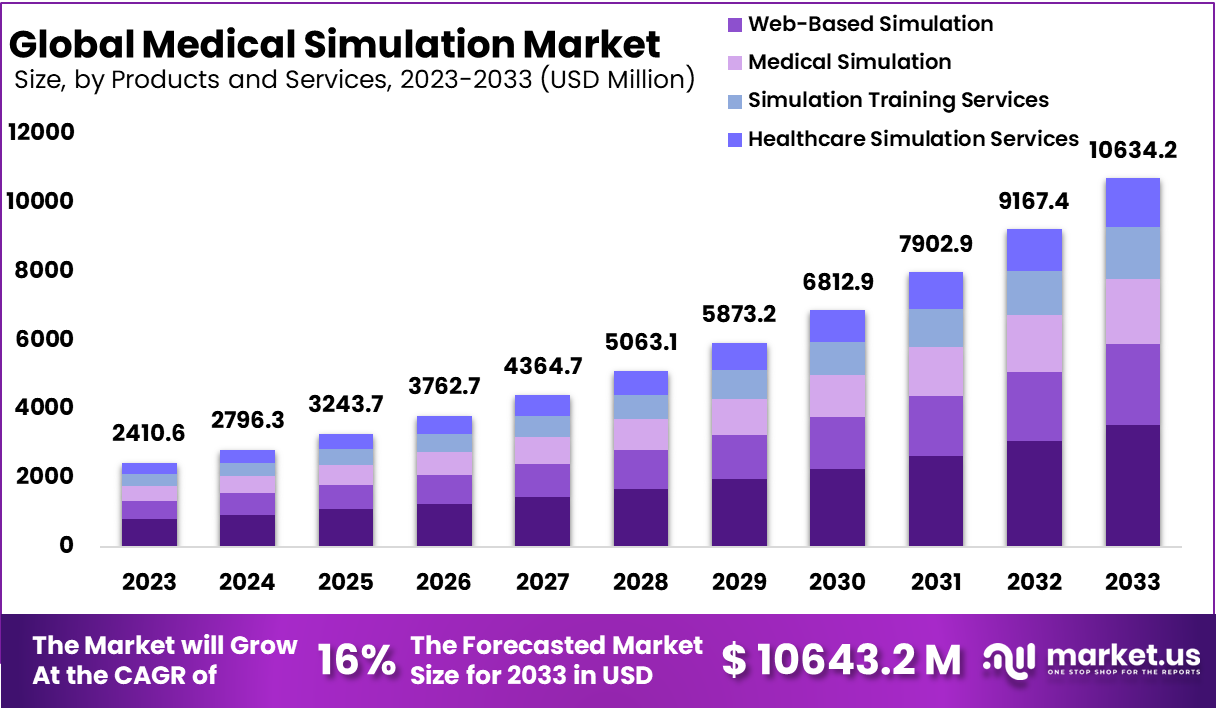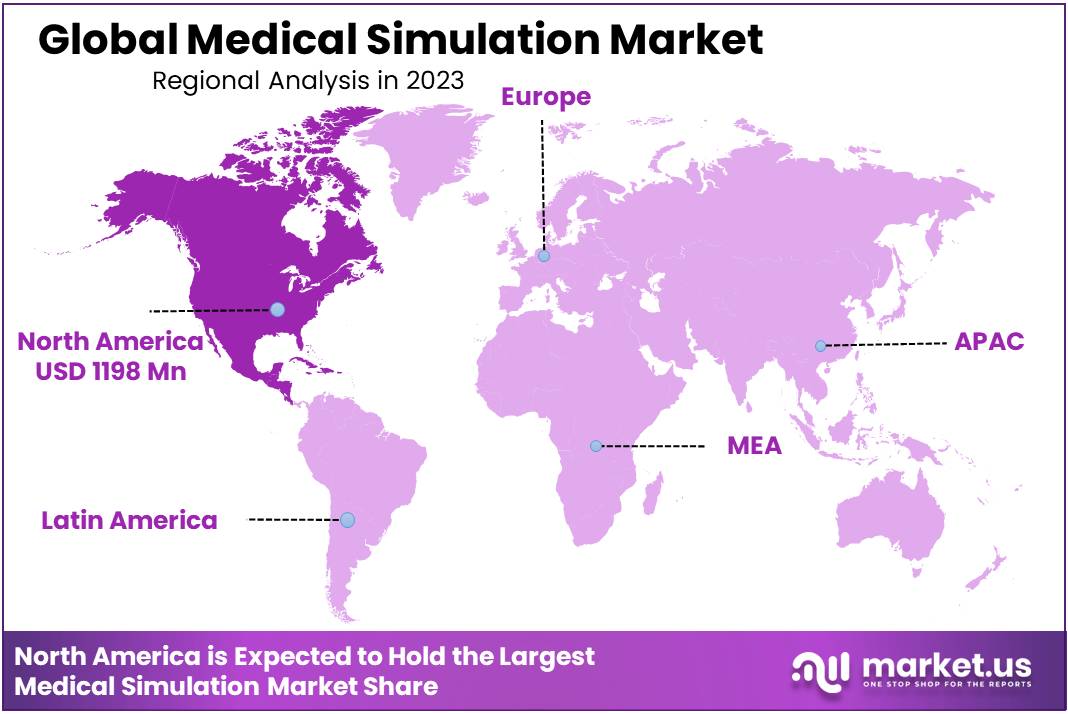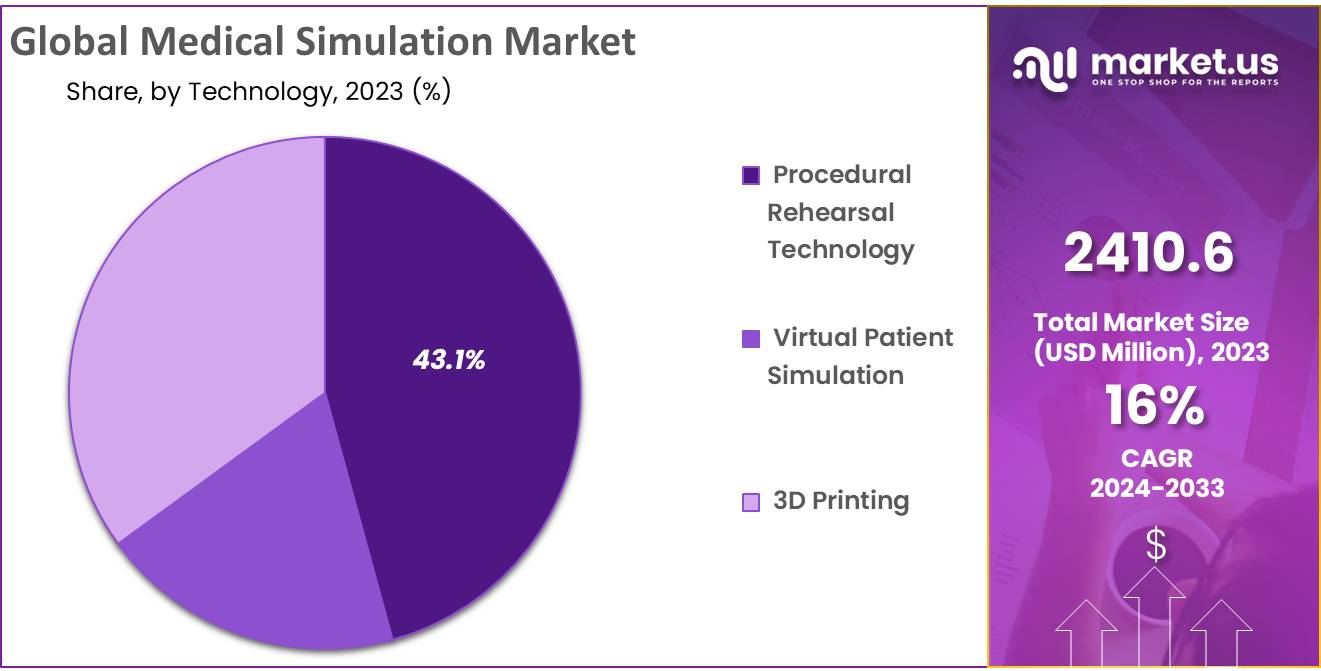New York, Feb. 06, 2024 (GLOBE NEWSWIRE) -- According to a recent report by Market.us, the Global Medical Simulation Market size is expected to be worth around USD 10,634.2 Million by 2033 from USD 2,410.6 Million in 2023, growing at a CAGR of 16% during the forecast period from 2024 to 2033.
Medical simulation is designed to educate and prepare healthcare professionals for tasks like surgery, prescribing medications, and general medical practice. This approach incorporates simulated patients, both human and artificial, to replicate clinical scenarios artificially. Referred to as clinical simulation or healthcare simulation, this modern method is essential for healthcare practitioners who may not always have the opportunity to participate in real-life patient care. The increased utilization of medical simulation is driven by factors such as the need to address medical errors and the growing recognition of its effectiveness.
Want to Know More about Key Market Dynamics, Download a PDF Sample @ https://market.us/report/medical-simulation-market/request-sample/
Key Takeaway
- By products and services are considered, the market is classified into healthcare simulation anatomical models, patient simulators, task trainers. The healthcare anatomical simulation models segment emerged as dominant segment in 2023 by securing a market share of 33.4%.
- Based on technology, the market is divided into Virtual Patient simulation, 3D Printing, procedural rehearsal technology. Among these, the procedural rehearsal technology emerged as dominant in 2023 with a market share of 43.1%.
- When end-users for the market are considered, the segments observed in the market are academic institutes, hospitals, military organizations, and research. 2%.
- As far as regional segmentation is concerned, North America remained the highest contributing region with the market share reaching 47.9%.
Factors affecting the growth of the Medical Simulation market
- The laparoscopic devices market is being propelled by growing technological advancements, a shift towards less invasive treatments, and an emphasis on patient safety, driven in part by the impact of the COVID-19 pandemic.
- Efforts to enhance healthcare worker training, both through non-governmental and governmental initiatives, are contributing to market growth, supported by scholarships and technical developments in medical research.
- Alternatively, poorly designed medical simulators pose a significant restraint, potentially leading to destructive learning and medical errors in the future.
- Opportunities lie in increasing awareness about simulation training in emerging economies, driven by private investments and government initiatives in healthcare.
- Additionally, the trend towards minimally invasive treatments is significant, fueled by improved healthcare infrastructure and rising demand for safer medical practices, promising further market growth and trends in the foreseeable future.
Top Trends in the Global Medical Simulation Market
The enhancement of healthcare infrastructure, coupled with a growing recognition of unmet healthcare needs and rising incidents of medical errors, has given rise to new trends in emerging healthcare markets. Notably, an increasing number of medical care companies are introducing various minimally invasive treatments, contributing to the growth of key players in the market. This trend is expected to continue in the coming years, fostering market development and unveiling numerous trends in the near future.
Market Growth
The medical simulation market is poised for substantial growth driven by factors such as increasing investments in technology, rapid technological advancements, and a focus on patient safety. North America, with its significant market share and high-tech investments, remains a key driver. The Asia-Pacific region is expected to witness remarkable growth, propelled by continuous developments in healthcare infrastructure and the rising adoption of healthcare facilities. The market's trajectory is further influenced by the commitment of key players to innovation, strategic collaborations, and expanding their product portfolios, ensuring a dynamic landscape for future market expansion and advancements in healthcare training methodologies.
Macroeconomic Factors
Macroeconomic factors influencing the medical simulation market include global economic conditions affecting healthcare spending and technology investments. Regulatory standards and workplace safety regulations play a pivotal role, influencing demand for simulation solutions. Fluctuations in raw material prices, especially for advanced simulation technologies, impact production costs. Quality concerns may impact market competitiveness, with economic stability affecting consumer preferences. Additionally, healthcare expenditure globally, alongside government initiatives in public-private collaborations, contributes to market growth. Overall, economic conditions shape the industry landscape, impacting investments, regulatory compliance, and the adoption of simulation technologies in healthcare training, creating a dynamic and interconnected environment.
Regional Analysis
North America has secured a substantial share, constituting 49.7% of the revenue in the medical simulation market. This dominance is attributed to factors such as significant investments in technology and the presence of key regional players, contributing to market recognition and growth. Moreover, the region benefits from rapid technological advancements and high disposable income, further fuelling market expansion in the forecast period. The Asia-Pacific segment is anticipated to experience significant growth, driven by ongoing developments in healthcare infrastructure. Additionally, the rising adoption of healthcare facilities, coupled with a rapid increase in manufacturing services, contributes to the flourishing market growth in this region.

Explore the strategic advantages our report holds for your business. Request a brochure to find out more https://market.us/report/medical-simulation-market/#inquiry
Scope of the Report
| Report Attributes | Details |
| Market Value (2023) | USD 2,410.6 Million |
| Forecast Revenue 2033 | USD 10,634.2 Million |
| CAGR (2024 to 2033) | 16% |
| North America Share | 49.7% |
| Base Year | 2023 |
| Historic Period | 2018 to 2022 |
| Forecast Year | 2024 to 2033 |
Market Drivers
The medical simulation market is poised for growth driven by increasing technological advancements, a preference for less invasive treatments, and a heightened focus on patient safety. Despite the adverse impact of the COVID-19 pandemic on various market participants, the rise of medical simulation is attributed to its utilization in addressing medical errors and enhancing patient safety outcomes. Efforts, both governmental and non-governmental, to enhance the skills of healthcare workers contribute to market expansion. Initiatives like The Bob Waters Memorial Scholarship Fund aim to support students involved in healthcare simulation annually. Key market players are expected to leverage technological developments in medical research and the growing number of participants in the market.
Market Restraints
Poorly designed medical simulators pose a risk of destructive learning, potentially leading to future medical errors. For instance, the absence of physiological and physical symptoms in simulations may result in students overlooking critical indicators. Simulation-based education has the potential to encourage shortcuts, such as bypassing patient approval and safety procedures to expedite artificial skills over genuine ones. Moreover, the distinct approach to simulators compared to real-life situations can influence learners' attitudes.
Market Opportunities
There is a significant opportunity stemming from the increasing awareness of simulation training in emerging economies. While simulation for medical education has seen significant growth in well-resourced settings, it remains less prevalent in developing countries like India and China. These nations offer substantial growth potential for key players in the medical simulation market, driven by private investments, a rising number of medical institutions, and the overall expansion of the healthcare industry supported by government initiatives.
Report Segmentation of the Medical Simulation Market
Products and Services Insight
The global medical simulation market is categorized based on products and services, encompassing healthcare anatomical simulation models, web-based simulation, medical simulation, simulation training services, and healthcare simulation services. Further, within the healthcare anatomical simulation model segment, there are sub-segments including patient simulators, task trainers, interventional/surgical simulators, and ultrasound simulators. In these the healthcare anatomical simulation models generated the most revenue in 2023, with the market share of 33.4%.
Technology Insight
In terms of technology, the medical simulation market is segmented into virtual patient simulation, 3D printing, and procedural rehearsal technology. The procedural rehearsal technology segment holds the largest market revenue share at 43.1%. The demand for procedural rehearsal technology is expected to increase, driven by a growing incidence of medical errors and the consequent emphasis on enhancing patient safety.
End-Use Insight
The global medical simulation market is categorized by end-users, including academic institutes, hospitals, military organizations, and research. The segment of academic institutes holds the dominant market share, driven by the ongoing expansion of academic research groups engaged in the study of complex biological systems using computer models. The market share of this particular segment reached 45.2% in 2023.
Unlock Instant Access | Acquire This Premium Research Report https://market.us/purchase-report/?report_id=101985
Recent Development of the Medical Simulation Market
- In June 2023, Laerdal Medical, a renowned provider of patient simulation solutions, and SimX, a leading company in virtual reality medical simulation, announced a collaboration aimed at enhancing patient safety through a VR simulation training solution. This partnership offers proprietary tools designed to manage dialogue, animations, and patient vitals, ensuring full engagement of learners as they progress towards training goals. As part of the collaboration, Laerdal will serve as a primary distributor of the SimX virtual reality simulation platform for hospitals, EMS, and government clients in the United States and Canada.
- In January 2024, GigXR, Inc., a worldwide supplier of extended reality (XR) solutions for healthcare training, announced plans to team up with CAE Healthcare to improve the efficiency and effectiveness of clinical simulation. Their partnership aims to streamline the implementation and management of multimodal simulation across various sectors including medical schools, nursing schools, hospital systems, first responders, and government agencies.

Market Segmentation
By Products and Services
- Healthcare Anatomical Simulation Models
-
- Patient Simulators
- Task trainers
- Interventional /Surgical Simulators
- Ultrasound Simulators
- Web-Based Simulation
- Medical Simulation
- Simulation Training Services
- Healthcare Simulation Services
By Technology
- Virtual Patient Simulation
- 3D Printing
- Procedural Rehearsal Technology
By End-User
- Academic Institutes
- Hospitals
- Military Organizations
- Research Organizations
By Geography
North America
- US
- Canada
Europe
- Germany
- France
- The UK
- Spain
- Italy
- Russia
- Netherland
- Rest of Europe
Asia Pacific
- China
- Japan
- South Korea
- India
- New Zealand
- Singapore
- Thailand
- Vietnam
- Rest of APAC
Latin America
- Brazil
- Mexico
- Rest of Latin America
Middle East & Africa
- South Africa
- Saudi Arabia
- UAE
- Rest of MEA
To Gain greater insights, Request a sample report @ https://market.us/report/medical-simulation-market/request-sample/
Competitive Landscape
The competitive landscape of the medical simulation market is marked by the presence of key players investing in technological advancements and strategic collaborations. Industry leaders maintain significant market shares through continuous innovation and product development. The market witnesses intense competition with players focusing on expanding their product portfolios and global presence. Emerging players, including Kyoto Kagaku Co., Ltd. and Simulab Corporation, are gaining traction through a proactive approach in adapting to evolving market demands. Overall, the competitive dynamics are driven by a commitment to enhancing healthcare training methodologies and improving patient outcomes.
Market Key Players
- CAE Healthcare, Inc.
- Laderdal Medical
- 3D Systems, Inc.
- Simulab Corporation
- Limbs &Things Ltd
- Kyoto Kagaku Co, Ltd.
- Mentice AB
- Surgical Science Sweden AB
- Gaumard Scientific
- Intelligent Ultrasound Limited
- Cardionics, Inc.
- Inovus Medical
- Other Key Players
Explore Extensive Ongoing Coverage on Life Science Market Research Reports Domain
- Advanced Wound Dressing Market was valued at USD 9,352.4 million in 2021. This number will increase at a CAGR of 5.5% between 2023-2032
- Dialysis Equipment Market was valued at US$ 11.3 Billion. Between 2023 and 2032, this market is estimated to register the highest CAGR of 6.2%
- Alpha1-Proteinase Inhibitor Market was valued at UЅD $1,199.3 Мn in 2020, and is projected to register а САGR of 7.1%.
- Cystoscope Market is projected to be US$ 436.6 Mn in 2022 to reach US$ 767.2 Mn by 2028 at a CAGR of 5.8%.
- Energy Based Non-Invasive Medical Aesthetic Treatment system Market is projected to be US$ 3,168.3 Mn in 2018 to reach US$ 7,487.8 Mn by 2028 at a CAGR of 9%.
- Dentures Market size is expected to be worth around USD 2.9 Billion by 2033 from USD 1.3 Billion in 2023, growing at a CAGR of 8.4% during the forecast period from 2024 to 2033.
- Minimally Invasive Surgical Instruments Market size is expected to be worth around USD 86.8 Billion by 2032, from USD 35.1 Billion in 2023
- Cosmetic Dentistry Market size is expected to be worth around USD 145.3 Billion by 2033, from USD 38.5 Billion in 2023
- Laparoscopic Devices Market size is expected to be worth around USD 17.2 billion by 2032, from USD 8.5 billion in 2023
- Nerve Repair and Regeneration Market Size is projected to reach approximately USD 32.4 Billion by 2033, marking a substantial increase from USD 9.2 Billion in 2023
About Us
Market.US (Powered by Prudour Pvt Ltd) specializes in in-depth market research and analysis and has been proving its mettle as a consulting and customized market research company, apart from being a much sought-after syndicated market research report-providing firm. Market.US provides customization to suit any specific or unique requirement and tailor-makes reports as per request. We go beyond boundaries to take analytics, analysis, study, and outlook to newer heights and broader horizons.
Follow Us on LinkedIn
Our Blog:
